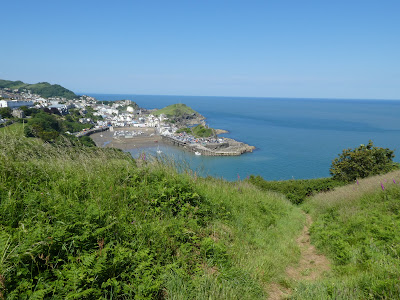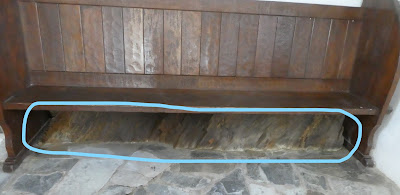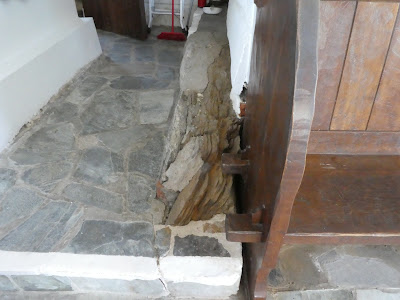Marseille's harbour by night as seen from our hotel room
I have recently been on an excursion to Marseille. It is a little less than two hours west of our Olive Farm in the direction towards Spain. Marseille is an ancient harbour city set right in the middle of the stretch of Mediterranean that fringes the south of France. I have written at length in my two travel books,
The Olive Route and
The Olive Tree, about the birth of Marseille which at that time - 600 BC - was christened Massalia. Massalia was founded as a trading post by Phocaeans, Greeks settled in Asia Minor. Their name came from the small harbour city Foça, which today is a pretty, rather sleepy little town on the Aegean coast in Izmir Province, Turkey.
For me, one of the important facts about these Asia Minor Greek traders is that they brought with them the knowledge and the trees to begin the first olive farms and olive oil production in France. Olive oil was a cornerstone of their diet, also used for cosmetics and as a health product. The legacy of that knowledge can be seen everywhere today.
A silver drachma inscribed with the name Massa, for Massalia. The head is the Greek goddess, Artemis. This coin is dated approximately 375 BC.
La Rade, which includes the Harbour area, some neighbourhoods of the old town and a small archipelago, has been on the UNESCO Tentative List since 2002, waiting to be given World Heritage status. I am very surprised that it is taking so long. It is a truly magnificent area and leaves you in no doubt about the importance of this city and its colourful and multicultural history.
Here is a photo I uploaded from the internet of a corner of the
Jardin des Vestiges, near the Vieux-Port, where you can very clearly see the remnants of the ancient port.
Marseille is a city with a long and colourful history and much of that history has come about because it is such an active port city. On this recent visit, I spent my days walking the hilly streets, taking photographs, visiting old buildings and generally imbibing the lively atmosphere of the city.
I spent a morning in Le Panier district, which is rich with both history and twenty-first century living. It is the oldest quarter of the city and quite hilly so you will need good footwear. I was heading, in a very leisurely fashion, from our hotel down at the Quai du Port towards La Vieille Charité, which I had never visited before. It is worth the climb.
I paused every two or three minutes to take photographs, to read the city's many information markers and to take in the general atmosphere.
There is soap for sale everywhere, many small boutiques offering every possible scent and shape. There are soap factories to be visited if you are interested in learning the city's soap history. Aleppo in Syria has always been regarded as the world's great soap manufacturer. Pure virgin olive oil is the base ingredient for the soaps of both Aleppo, which also includes oil of laurel, and also of Marseille. Marseille has been producing olive oil soap since the fourteenth century. The first factory, savonnerie, was opened there in 1593. By 1660, there were seven factories in the city using locally-produced olive oil as their base product and producing twenty thousand tons of soap a year.
In 1688, King Louis XIV introduced the Edict of Colbert, which clearly laid out the regulations limiting the use of the name "Savon de Marseille".
They were:
The soap must be made in the city of Marseille
It must be heated in cauldrons
It must be made using only pure virgin olive oil
It must include no animal fats
Any soap manufacturer found to be breaking these rules risked banishment from Provence forever!
Back then, one bought the soap in either five-kilo bars or twenty-kilo bars loaves. A loaf of soap!
Today, Savon de Marseille is certainly a tourist attraction and factories such as Cheval de Fer offer tours. Almost every hotel will have Marseille soap products in the bathroom.
King Louis's edict has long since been set aside and many of the modern soaps are made from oil mixes that might include copra oil as well as soda-ash, and sea salt. There are still some that label themselves olive oil soap. I always look out for those.
Two photos I took in a soap boutique close to La Vieille Charité. As you can see, one of their specialities is soap in the shape of long fish (about the size of a mackerel!)
La Vieille Charité built between 1671 and 1749 was an almshouse that has been transformed into a very splendid arts and cultural centre. It is beautiful. I long to go back there. Alongside the several very interesting exhibitions showing there, I came across an almost secret library specialising in poésie. CIPM, Centre International de Poésie Marseille. A cool vaulted space set within one of the four arcaded galleries that surround the central chapel. Entrance to la bibliothèque is free. They are open from Wednesdays to Saturdays in the afternoons.
There are both temporary and permanent exhibitions running at La Vieille Charité. The location is a cool tranquil place to enjoy hours of history and art away from the madness and heat of summer in this ancient city.
Here are a few of the many pictures I took.
Shakespeare's shelf at the Library of International Poetry. In spite of being dedicated to modern works, they do have a very fine collection of classics. I spotted Yeats and Joyce nestling beneath the Bard in the English language section. Goethe along the German shelves.
One of the four arched galleries that surround the chapel.
How cool to spend afternoons hidden away at this library table quietly reading tomes of poetry while, beyond the substantial walls, the city goes about its crazy cosmopolitan business.
Back out in the narrow descending lanes, I stopped to admire the street art of which there are copious examples especially in this Panier district. I was on the hunt for a Pastis distillery, hoping to find someone who might recount to me the history of this infamous aniseed apéritif, which is enjoying a revival. Pastis is an old Provençal word meaning 'mixture' for that is what the drink consists of. A magical combination of water and sweet spirit made from an aniseed base. When the chilled water descends into the glass and combines with the liquor, the liquid turns cloudy, milky-white, and the scent of star aniseed and liquorice rises to hit one's nostrils.
I found this artwork painted on the side of a building.
Isn't he splendid? It is a modern take, I believe, on the famous Pastis Olive advert of the past. See here, this was attached to a shop doorway.
and here:
We have a framed copy of this poster hanging in our house in the north. The original of this was designed in 1936.
Ricard and Pernod are the two grand marks of Pastis. Both were founded in Marseille and both are now owned by the Ricard family, which has expanded into a global empire. In 1932, Pastis was created and introduced by Paul Ricard, the son of a family of wine-makers. This was some seventeen years after the ban on Absinthe. Soon after, Pernod, a former Absinthe producer, began to produce its own version of the Pastis apéritif.
Pastis very quickly became the trendy early evening tipple in Marseille.
In 1936, paid holidays were introduced for the first time in France, brought into law by France's first Jewish Prime Minister, the socialist Léon Blum. That same year, the famously opulent Le Train Bleu added third class carriages to accommodate the descent south of the working classes.
Luxuriating in the heat and the easier way of living, everyone took to quaffing Pastis. It carried with it an image of sun, blue skies and sea. A very clever marketing campaign created by Paul Ricard. When the workers returned north, the drink went with him. It was no longer simply a southern tipple, but a national success.
In 1940, the Vichy government prohibited the production of Pastis. It was eleven years before it was allowed back onto the market.
In 1975, Paul Ricard bought Pernod and the two companies merged. Today, the Pernod-Ricard group is the second largest wine and spirits distributor in the world and number one in Europe. Most surely, a local story turned good.
Another local story of invention and celebration is the
santons. I crept into a lovely shop filled with nothing but these lovely hand-painted nativity figurines of all sizes.
Provencal figurines
Santons were invented in Marseille. The Provencal word
Santoun means 'Little Saint'. The first clay
santons were created by the Marsellais artisan, Jean-Louis Lagnel (1761 - 1822) during the French Revolution when the churches were closed down, midnight mass was cancelled and nativity scenes were prohibited. He began moulding the earliest figurines in 1797, out of clay to make them affordable for everyone and so that every family could install a nativity scene in their own home and continue to worship, albeit illegally, within the privacy of their own home.
Lagnel was born one street away from the almshouse, La Vieille Charité. I passed the plaque honouring him.
Here is an article I wrote for this blog some time back:
After idling away time in the old streets of Le Panier, I headed down to the waterside to meet my husband for lunch at an excellent new restaurant, Coquille, recently opened since the relaxing of lockdown here. On my way, I passed several memorial plaques attached to the walls in various streets in this old part of the city, in the first arrondissement.
They stopped me in my tracks not because I didn't know about them or the tragedy they are commemorating. It is a tragic part of Marseille's modern history and plays a role in my new novel, AN ACT OF LOVE. A role that in a small way is crucial to the plot.
The Marseille Roundup caused the destruction of the old quarters of the city bordering the old port in the Nazi's obsessive hunt for Jews. In January 1943, two months after Hitler had ordered his soldiers to cross over into the Free Zone of France, Wehrmacht soldiers entered Marseille. The Marseille Roundup, which took place between 22nd and 24th January 1943, saw the arrest of over 2,000 Jews who were loaded onto to trains to Drancy before being cattle-shipped to the extermination camps. What is most shocking is that these actions were carried out under the direction and full knowledge of the Vichy regime. French police under the leadership of René Bousquet led the operation. Forty thousand people were stopped by the police, their papers checked. Six thousand arrested. The police burned and razed to the ground the streets and living quarters surrounding the old port, which was judged by the Germans to be a terrorist nest.
This stain on French history is one the most heinous examples of WWII collaboration.
Evacuation of the Old Port, 1943.
On a lighter note, I passed a delicious afternoon at MUCEM, the wonderful new (opened in 2013) Museum of European and Mediterranean Civilizations, situated at the end of Quai du Port. Amongst their new exhibitions is one on La Grand Mezze. Lots to discover on Mediterranean food. Even if none of the exhibitions on offer are of interest to you, this is a very special place situated right on the water. Visiting, wandering from space to space, is a unique experience. It offers cultural programmes as well. I recently attended a seminar on the Mediterranean diet. MUCEM looks at from both a historical and modern perspectives all issues that involve the Mediterranean, its peoples and this rich cradle of civilisations. It is the first museum in the world devoted exclusively to Mediterranean issues and cultures.
An evening drink - a Pastis or rosé - at le Bar de la Marine at 15 Quai de la Rive Neuve. The exterior of the original bar was used in the trilogy of Marcel Pagnol films. The interior scenes were shot in studios in Paris. The original bar was dynamited by the Nazis and then, later, rebuilt. I missed a stopover there on this last trip but intend to return next month. It's on my list to discover.
There is so much to discover in this wonderful city.
By the way, several chapters of my novel THE HOUSE ON THE EDGE OF THE CLIFF, are set in Marseille. I have been visiting the city since I was twenty-two. It feeds me endless inspiration.

































